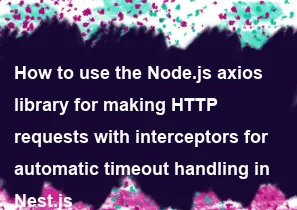How to use the Node.js axios library for making HTTP requests with interceptors for automatic timeout handling in Nest.js

To use Axios with interceptors for automatic timeout handling in a Nest.js application, you can create a custom interceptor to handle timeouts. Here's how you can achieve this:
Install Axios:
First, ensure you have Axios installed in your Nest.js project. If not, you can install it using npm or yarn:
npm install axiosor
csharpyarn add axiosCreate a TimeoutInterceptor:
In Nest.js, interceptors are used to intercept and manipulate requests and responses. You can create a custom interceptor to handle timeouts.
typescript// timeout.interceptor.ts import { Injectable, NestInterceptor, ExecutionContext, CallHandler, HttpException, HttpStatus } from '@nestjs/common'; import { Observable, throwError, TimeoutError } from 'rxjs'; import { catchError, timeout } from 'rxjs/operators'; import axios, { AxiosRequestConfig } from 'axios'; @Injectable() export class TimeoutInterceptor implements NestInterceptor { intercept(context: ExecutionContext, next: CallHandler): Observable<any> { const request = context.switchToHttp().getRequest(); const timeoutValue = request.timeout || 5000; // Default timeout is 5 seconds return next.handle().pipe( timeout(timeoutValue), catchError(error => { if (error instanceof TimeoutError) { throw new HttpException('Request timed out', HttpStatus.REQUEST_TIMEOUT); } else { return throwError(error); } }) ); } }In this interceptor, we're setting a default timeout value of 5 seconds (5000 milliseconds). You can adjust this value according to your requirements. Additionally, if the timeout is reached, the interceptor throws an HTTP exception with status code 408 (Request Timeout).
Register the TimeoutInterceptor:
Register the
TimeoutInterceptorin your Nest.js module to apply it to HTTP requests.typescript// app.module.ts import { Module, NestModule, MiddlewareConsumer } from '@nestjs/common'; import { TimeoutInterceptor } from './timeout.interceptor'; @Module({ providers: [ { provide: APP_INTERCEPTOR, useClass: TimeoutInterceptor, }, ], }) export class AppModule {}Use Axios for HTTP Requests:
Now, you can use Axios for making HTTP requests within your Nest.js services or controllers. The interceptor will handle timeouts automatically.
typescriptimport { Injectable } from '@nestjs/common'; import axios from 'axios'; @Injectable() export class ApiService { async fetchData(): Promise<any> { try { const response = await axios.get('https://api.example.com/data', { timeout: 10000 }); // Set custom timeout if needed return response.data; } catch (error) { throw error; // Let Nest.js handle error responses } } }In this example, we're setting a custom timeout value of 10 seconds (10000 milliseconds) for the specific request. This overrides the default timeout value set in the interceptor.
With this setup, Axios will automatically handle timeouts for HTTP requests in your Nest.js application. Adjust the interceptor's timeout value and the custom timeout values in individual requests according to your specific requirements.
-
Popular Post
- How to implement multi-language support in an Express.js application
- How to handle and optimize for changes in mobile search behavior
- How to optimize for Google's About This Result feature for local businesses
- How to configure Laravel Telescope for monitoring and profiling API requests
- How to use Vue.js with a UI framework (e.g., Vuetify, Element UI)
- How to handle CORS in a Node.js application
- How to create a command-line tool using the Commander.js library in Node.js
- How to implement code splitting in a React.js application
- How to use the Node.js Stream API for efficient data processing
- How to use the AWS SDK for Node.js to interact with various AWS services
- How to implement a cookie parser middleware in Node.js
- How to implement WebSockets for real-time communication in React
-
Latest Post
- How to implement serverless authentication with Firebase Authentication in a Koa application
- How to use the Node.js axios library for making HTTP requests with interceptors for FormData and file uploads in Koa
- How to implement a custom middleware for handling multipart form data in a Koa application
- How to use the Node.js axios library for making HTTP requests with interceptors for automatic redirection handling in Koa
- How to implement serverless authentication with AWS Cognito in a Koa application
- How to use the Node.js axios library for making HTTP requests with interceptors for automatic retries in Koa
- How to implement a custom WebSocket authentication strategy in a Koa application
- How to use the Node.js axios library for making HTTP requests with interceptors for automatic cookie handling in Koa
- How to implement serverless authentication with Auth0 in a Koa application
- How to use the Node.js axios library for making HTTP requests with interceptors for automatic JSON parsing in Koa
- How to implement a custom rate-limiting middleware with Redis in a Koa application
- How to use the Node.js axios library for making HTTP requests with interceptors for retries and timeouts in Nest.js